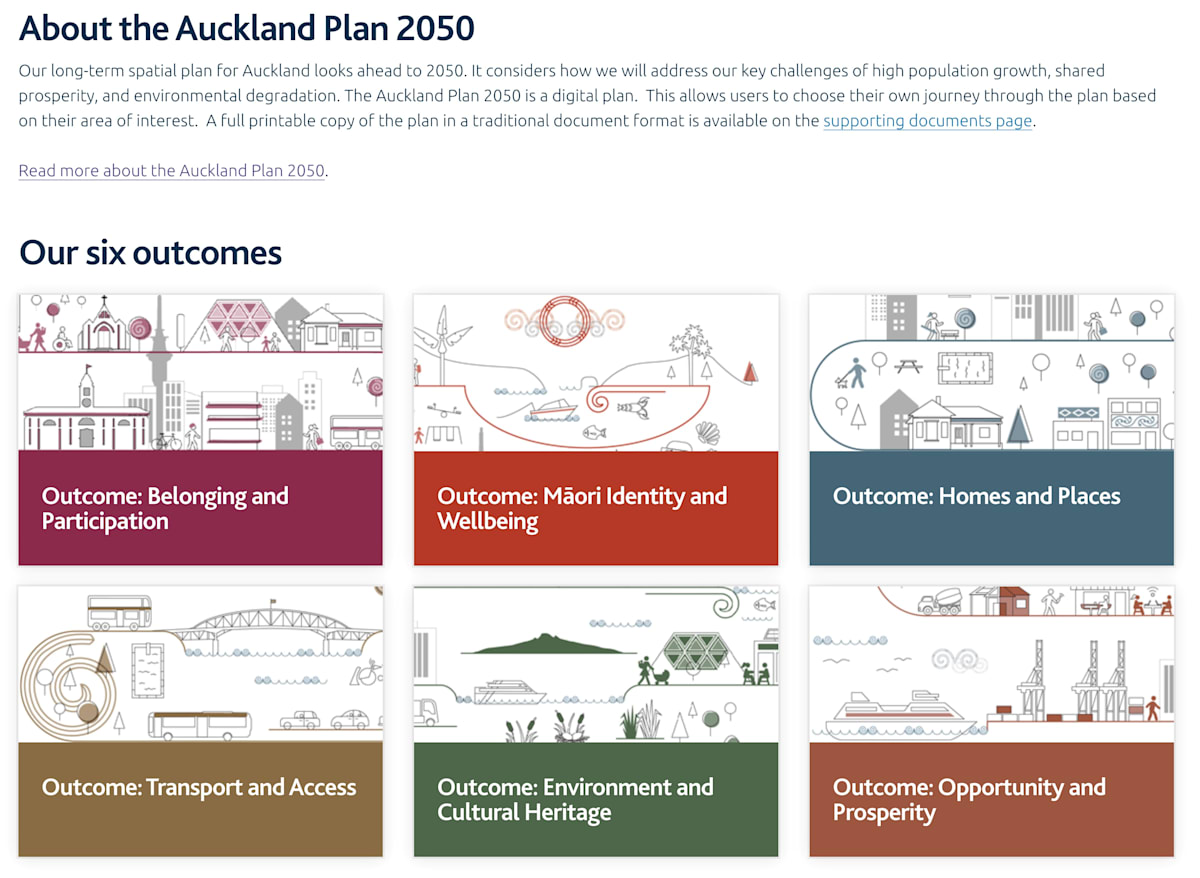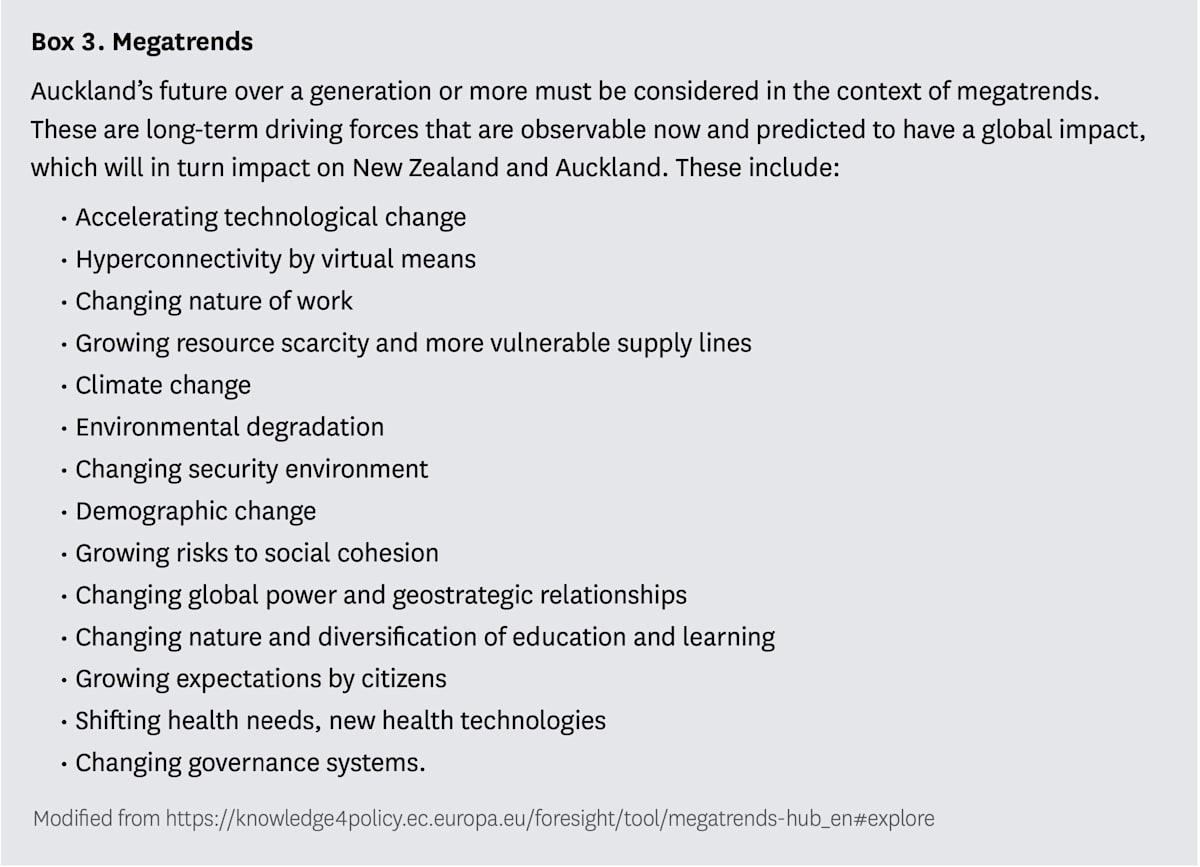
This week's much-vaunted report on Auckland's tomorrows is stuck in solutions of the past
Opinion: Reimagining Tāmaki Makaurau Auckland describes to us what our city could be by 2070.
The work of Sir Peter Gluckman’s think tank, Koi Tu: The Centre for Informed Futures, it draws on “a range of perceptions, trends and dynamics” captured from interviews with “more than 120 expert and stakeholder interviews and focus groups.”
The report develops seven themes to paint a picture of our potential lives 50 years from now:

There is one new buzz phrase in this: National Park City. All the rest would seem remarkably familiar to anyone who has taken a passing interest in the future of Auckland over the past 15 years or so.
For example, this is the key graphic from Auckland Council’s 2050 Plan adopted in 2018:

And this chart from Auckland Council 2040 Plan, adopted in 2012:

And the extensive findings of the Royal Commission on Auckland Governance in 2009. All its research and reports are still available. (Disclosure: I was hired by the commission to research and write a foresight report, Auckland 2060.)
The Auckland Council and related agencies that commissioned it hailed the publication of Reimagining Tāmaki Makaurau Auckland this week.
“There is incredible depth in this report and it will take time for Aucklanders and government agencies to fully absorb its implications,” said Nick Hill, chief executive of Auckland Unlimited, the council’s economic development agency.
“It is insightful and inspiring and we hope it will provoke robust discussion and debate among Aucklanders and New Zealanders so Tāmaki Makaurau Auckland can realise its great potential to benefit us all,” he added.
“Auckland Unlimited will pick up and run with the region of creativity and culture, and innovative region scenarios from the report as they fall squarely within our mandate. The report validates the work we are already doing in these areas and encourages us to accelerate it.”
Yet, for all the enthusiasm of those who commissioned and reported on Reimagining Tāmaki Makaurau, the document has few new insights about the present, let alone the future. It offers only simplistic, fleeting references to the great upheavals accelerating in climate, technology, economics and democracy. And some of those references are misleading.
As for megatrends, the report offers this summary below.

Indeed these, and many more, are fomenting great insights into the nature of cities, and triggering radical new approaches. This is the long-established field of urbanism. But that multidisciplinary approach to cities rates only one mention in the report (in a footnote on page 21). Urbanists, the experts, get no mention at all.
Yet, urbanism – the science and art of placemaking - has been around a long time. Here’s a list, compiled by one of its professional bodies, of the “100 most influential urbanists of all time.”
We have deeply insightful urbanists here in Auckland and New Zealand. Crucially, their work reflects the particular character and opportunities of our places.
“We can rethink where we live and how we get around, and transition to a society that is more affordable, more equitable, healthier, and with much lower greenhouse gas emissions. This will be better for all urban residents, especially low-income and vulnerable people,” John Polkinghorne wrote last September on the Greater Auckland website.
Women in Urbanism Aotearoa is another example of the rich depth of local knowledge and insights. “Our mission is to transform our towns and cities into more beautiful, inspiring and inclusive places for everyone. We do this by amplifying the voices and actions of all self-identifying wāhine, girls and non-binary people.”
If those organisations or some of their members were among the stakeholders Gluckman’s team interviewed, their wisdom and knowledge is absent from the report.
Where the report does pick up on a few transformations fundamental to 21st Century cities, it gives superficial or, worse, misleading, explanations of them. Here are three examples:
Circular economy: By 2070, “the region supports a circular economy by reducing consumption, reusing and recycling, and minimising waste,” according to the report’s scenario.
No. A circular economy is a far more radical transformation. This is the definition according to the Ellen Macarthur Foundation, a global leader in the field:
“The circular economy is based on three principles, driven by design:
- Eliminate waste and pollution
- Circulate products and materials (at their highest value)
- Regenerate nature.
It is underpinned by a transition to renewable energy and materials. A circular economy decouples economic activity from the consumption of finite resources. It is a resilient system that is good for business, people and the environment.”
Urban structure: Gluckman’s report describes “a region of integrated precincts,” areas of the city and region which are highly specialised, and with good transport connections between them.
That’s an old concept which will continue to play a role. But far more sustainable and liveable concepts, are emerging. One is the “15-minute city” in which work and many aspects of life are within that quick a public or active transport journey from home.
Paris is one example of a city that’s embracing the concept. Hamilton, yes, the Tron, is another, albeit stretched to 20 minutes.
Nature in the city: The report says: “Sustainability is not just about doing less harm, but about implementing approaches that aim for a net positive effect – putting back into society and the environment more than is extracted from it, which is also known as being ‘regenerative’.”
One of the few examples it gives is the National Park City. This idea began in London in 2017 to make its existing and newly built-environments greener. Undaunted by their very limited impact on the city so far, its advocates are seeking to build an international alliance.
The far more fundamental imperative, though, is to bring nature back into cities to make them largely sufficient, for example, for energy, food and other resources; to be delightful, inspiring places to live and work; and to restore our symbiotic relationship with ecosystems, our life support systems.
The concept at the heart of this is biophilia. And there is a vibrant organisation of cities such as Singapore and Birmingham pursuing it. Wellington is the lone NZ member. One of the NZ experts is Maibritt Pedersen Zar, an associate professor at AUT and previously a deputy head of the architecture school at Victoria University of Wellington. Examples of her presentations are here. She was also one of the speakers in a Wellington conference last year, a full report of the event is here.
Tāmaki Makaurau should be an international exemplar of a biophilic city.
Having come up short on new insights and ambitions, or even an adequate global perspective, the Koi Tu report then turns to “delivery.” This table from the report summarises the “key enablers” it’s advocating.

Seeking ways to energise those enablers, the report advocates for “deliberative and participatory democratic techniques.” It sees the likes of citizen and youth assemblies as new ways to “enable broad citizen participation and deliberation in future planning” and thereby generate greater buy-in from citizens for big visions and plans.
But the report seems to miss the key to such new democratic practices: they work best when they have real power to make political decisions. One example is “participatory budgeting.”
The Sortition Foundation is one of many good places to learn more about deliberative and participatory democracy. Another is Institut Montaigne in France, and here in New Zealand Inclusive Aotearoa Collective Tāhono
But rather than advocating for real participatory democracy, Koi Tu relegates citizens to advisers while hoping the local and central government can reorganise themselves to make better decisions.
This is also its view of youth assemblies. It relegates them to advisory bodies while advocating for a Future Generations Commissioner. That, though, is solely a mechanism for inserting a youth advocate in government. It doesn’t give younger generations a direct voice. Moreover, anyone over 30 would be too old for such a job, and nobody under about 45 would stand a chance of being appointed by the government.
Koi Tu practises what it preaches. Its reference group for this report consisted of 18 prominent people (who are not a representative cross-section of the city's leaders) supplemented by three “Rangatahi Chairs”. There were seven references to rangatahi in the report. But their voices and ambitions were not explicitly expressed in the report.
Yet that generation is very capable of speaking for itself and acting very decisively. For example, it was Generation Zero that initiated and led the campaign for the zero carbon bill passed by parliament in 2019.
Bronwyn Hayward, a professor of political science at Canterbury University, is an international expert on such youth activism. She is also an author on the UN’s IPCC climate reports. An example of her knowledge is this December 2021 interview, titled Citizenship, Critical Hope, and Climate Change.
Another way to test the quality of a report is to look at its list of references. Crucially, are they pertinent and diverse? Do they seem to offer insight and inspiration?
In the case of this Koi Tu report on Auckland in 2070 the list runs to some 70 entries. But they are over-weight on social science, while climate has only one major generic source, and the leading edge of business, economics and political science barely get a look-in.
There is one ray of light in the 91-page report. A lone paragraph says: “The political philosopher Roman Kraznaric, in his book The Good Ancestor (2020), notes that ‘Cities are far more effective than nation states at tackling long-term problems ... If you are looking for innovative long-termism, the place to find it is at city level’.
But that ignores the far bigger message of the book, one which should have run through the entire report: What we have to have is the rebalancing between social wealth and ecological protection whereby we meet the needs of current and future generations within the means of Earth’s crucial life-supporting systems.
The science, literature and practice of that is well established and expanding very fast. There are many leaders across multiple fields. One happens to be Kraznaric’s wife, Kate Raworth, the founder of Doughnut Economics, summarised in this chart.

Here are two deeply insightful discussions Kraznaric and Raworth were involved in last September. The first is called “What Could Possibly Go Right?” and the second was at Columbia University.
Raworth visited New Zealand in 2019 to give a number of presentations. One was at the Government’s Just Transitions Summit. A recording is here.
Raworth’s Doughnut Economics Action Lab has fast become one of the leading centres for city transformations. An excellent example is the future the people of Amsterdam are building for themselves with the Lab’s help.
That’s what true 21st Century city transformation looks like. Against that benchmark, Gluckman’s Koi Tu report is a dismal exercise in back to the future.







